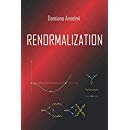We consider higher-derivative perturbations of quantum gravity and quantum field theories in curved space and investigate tools to calculate counterterms and short-distance expansions of Feynman diagrams. In the case of single higher-derivative insertions we derive a closed formula that relates the perturbed one-loop counterterms to the unperturbed Schwinger-DeWitt coefficients. In the more general case, we classify the contributions to the short-distance expansion and outline a number of simplification methods. Certain difficulties of the common differential technique in the presence of higher-derivative perturbations are avoided by a systematic use of the Campbell-Baker-Hausdorff formula, which in some cases reduces the computational effort considerably.
J. High Energy Phys. 10 (2007) 099 | DOI: 10.1088/1126-6708/2007/10/099
We prove the renormalizability of various theories of classical gravity coupled with interacting quantum fields. The models contain vertices with dimensionality greater than four, a finite number of matter operators and a finite or reduced number of independent couplings. An interesting class of models is obtained from ordinary power-counting renormalizable theories, letting the couplings depend on the scalar curvature R of spacetime. The divergences are removed without introducing higher-derivative kinetic terms in the gravitational sector. The metric tensor has a non-trivial running, even if it is not quantized. The results are proved applying a certain map that converts classical instabilities, due to higher derivatives, into classical violations of causality, whose effects become observable at sufficiently high energies. We study acausal Einstein-Yang-Mills theory with an R-dependent gauge coupling in detail. We derive all-order formulas for the beta functions of the dimensionality-six gravitational vertices induced by renormalization. Such beta functions are related to the trace-anomaly coefficients of the matter subsector.
Class. Quant. Grav. 24 (2007) 1927 | DOI: 10.1088/0264-9381/24/8/003
arXiv: hep-th/0611131
Consider an action $S$ depending on fields $\phi_{i}$, where the index $i$ labels both the field type, the component and the spacetime point. Add a term quadratically proportional to the field equations $S_{i}\equiv \delta S/\delta \phi _{i}$ and define the modified action
\begin{equation}
\phantom{(1)}\qquad\qquad\qquad S^{\prime }(\phi _{i})=S(\phi _{i})+S_{i}F_{ij}S_{j}, \qquad\qquad\qquad (1)
\end{equation}
where $F_{ij}$ is symmetric and can contain derivatives acting to its left and to its right. Summation over repeated indices (including the integrationover spacetime points) is understood. Then there exists a field redefinition
\begin{equation}
\phantom{(1)}\qquad\qquad\qquad\phi _{i}^{\prime }=\phi _{i}+\Delta _{ij}S_{j}, \qquad\qquad\qquad (2)
\end{equation}
with $\Delta _{ij}$ symmetric, such that, perturbatively in $F$ and to all orders in powers of $F$,
\begin{equation}
\phantom{(1)}\qquad\qquad\qquad S^{\prime }(\phi _{i})=S(\phi _{i}^{\prime }). \qquad\qquad\qquad (3)
\end{equation}
I prove that classical gravity coupled with quantized matter can be renormalized with a finite number of independent couplings, plus field redefinitions, without introducing higher-derivative kinetic terms in the gravitational sector, but adding vertices that couple the matter stress-tensor with the Ricci tensor. The theory is called “acausal gravity”, because it predicts the violation of causality at high energies. Renormalizability is proved by means of a map M that relates acausal gravity with higher-derivative gravity. The causality violations are governed by two parameters, a and b, that are mapped by M into higher-derivative couplings. At the tree level causal prescriptions exist, but they are spoiled by the one-loop corrections. Some ideas are inspired by the usual treatments of the Abraham-Lorentz force in classical electrodynamics.
JHEP 0701 (2007) 062 | DOI: 10.1088/1126-6708/2007/01/062
arXiv:hep-th/0605205
The infinite reduction of couplings is a tool to consistently renormalize a wide class of non-renormalizable theories with a reduced, eventually finite, set of independent couplings, and classify the non-renormalizable interactions. Several properties of the reduction of couplings, both in renormalizable and non-renormalizable theories, can be better appreciated working at the regularized level, using the dimensional-regularization technique. We show that, when suitable invertibility conditions are fulfilled, the reduction follows uniquely from the requirement that both the bare and renormalized reduction relations be analytic in $\varepsilon=D-d$, where $D$ and $d$ are the physical and continued spacetime dimensions, respectively. In practice, physically independent interactions are distinguished by relatively non-integer powers of epsilon. We discuss the main physical and mathematical properties of this criterion for the reduction and compare it with other equivalent criteria. The leading-log approximation is solved explicitly and contains sufficient information for the existence and uniqueness of the reduction to all orders.
J.High Energy Phys. 01 (2006) 077 | DOI: 10.1088/1126-6708/2006/01/077
arXiv: hep-th/0509196
I study the problem of renormalizing a non-renormalizable theory with a reduced, eventually finite, set of independent couplings. The idea is to look for special relations that express the coefficients of the irrelevant terms as unique functions of a reduced set of independent couplings $\lambda$, such that the divergences are removed by means of field redefinitions plus renormalization constants for the $\lambda$s. I consider non-renormalizable theories whose renormalizable subsector $R$ is interacting and does not contain relevant parameters. The “infinite” reduction is determined by $i$) perturbative meromorphy around the free-field limit of $R$, or $ii$) analyticity around the interacting fixed point of $R$. In general, prescriptions $i$) and $ii$) mutually exclude each other. When the reduction is formulated using $i$), the number of independent couplings remains finite or slowly grows together with the order of the expansion. The growth is slow in the sense that a reasonably small set of parameters is sufficient to make predictions up to very high orders. Instead, in case $ii$) the number of couplings generically remains finite. The infinite reduction is a tool to classify the irrelevant interactions and address the problem of their physical selection.
JHEP 0508 (2005) 029 | DOI: 10.1088/1126-6708/2005/08/029
arXiv:hep-th/0503131
The maximum pole of a diagram with $V$ vertices and $L$ loops is at most $1/\varepsilon^{m(V,L)}$, where $m(V,L)=\min (V-1,L).$ The result holds in dimensional regularization, where $\varepsilon = d-D$, $d$ is the physical dimension and $D$ the continued one. Moreover, vertices are counted treating mass terms and the other non-dominant quadratic terms as “two-leg vertices”.
Certain power-counting non-renormalizable theories, including the most general self-interacting scalar fields in four and three dimensions and fermions in two dimensions, have a simplified renormalization structure. For example, in four-dimensional scalar theories, $2n$ derivatives of the fields, $n>1$, do not appear before the nth loop. A new kind of expansion can be defined to treat functions of the fields (but not of their derivatives) non-perturbatively. I study the conditions under which these theories can be consistently renormalized with a reduced, eventually finite, set of independent couplings. I find that in common models the number of couplings sporadically grows together with the order of the expansion, but the growth is slow and a reasonably small number of couplings is sufficient to make predictions up to very high orders. Various examples are solved explicitly at one and two loops.
JHEP 0507 (2005) 077 | DOI: 10.1088/1126-6708/2005/07/077
arXiv:hep-th/0502237
I formulate a deformation of the dimensional-regularization technique that is useful for theories where the common dimensional regularization does not apply. The Dirac algebra is not dimensionally continued, to avoid inconsistencies with the trace of an odd product of gamma matrices in odd dimensions. The regularization is completed with an evanescent higher-derivative deformation, which proves to be efficient in practical computations. This technique is particularly convenient in three dimensions for Chern-Simons gauge fields, two-component fermions and four-fermion models in the large N limit, eventually coupled with quantum gravity. Differently from even dimensions, in odd dimensions it is not always possible to have propagators with fully Lorentz invariant denominators. The main features of the deformed technique are illustrated in a set of sample calculations. The regularization is universal, local, manifestly gauge-invariant and Lorentz invariant in the physical sector of spacetime. In flat space power-like divergences are set to zero by default. Infinitely many evanescent operators are automatically dropped.
Int.J.Mod.Phys. A20 (2005) 1389-1418 | DOI: 10.1142/S0217751X0501983X
arXiv:hep-th/0404053
In flat space, $\gamma_5$ and the epsilon tensor break the dimensionally continued Lorentz symmetry, but propagators have fully Lorentz invariant denominators. When the Standard Model is coupled with quantum gravity $\gamma_5$ breaks the continued local Lorentz symmetry. I show how to deform the Einstein lagrangian and gauge-fix the residual local Lorentz symmetry so that the propagators of the graviton, the ghosts and the BRST auxiliary fields have fully Lorentz invariant denominators. This makes the calculation of Feynman diagrams more efficient.
Phys. Lett. B 596 (2004) 90 | DOI: 10.1016/j.physletb.2004.06.089
arXiv:hep-th/0404032

 Quantum Gravity
Quantum Gravity 


